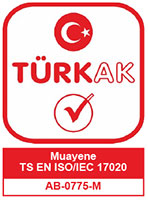Penetrant Testing (PT)
1. What is Penetrant Testing (PT)?
Penetrant testing is a non-destructive testing method used to detect exposed surface defects on non-porous, solid surfaces. This method is based on the principle that a colored or fluorescent liquid penetrant is applied to the surface, which penetrates into the defects and is then made visible with a suitable developer.
🧪 Basic Application Steps:
1. Surface Cleaning: Oil, paint, rust, and dirt must be completely removed.
2. Penetrant Application: Liquid penetrant is applied to the surface and left for a specified dwell time.
3. Removing Excess Penetrant: Excess penetrant is wiped off the surface, leaving only the penetrant within the defect.
4. Developer Application: The developer draws the penetrant within the defect to the surface.
5. Observation and Evaluation: Visual inspection is performed under white light (colored penetrant) or UV light (fluorescent penetrant).
💡 Method Types:
• Colored penetrant (visible red dye) – Red indicator on a white background.
• Fluorescent penetrant – Gives a bright yellow-green image under UV light.
________________________________________
✅ 2. What are the advantages over other NDT methods?
Very high surface crack sensitivity: Can detect even open cracks at the micron level.
Easy to apply: Can be easily applied by a trained technician.
Portable and field-friendly: Can be applied in the field with small kits (aerosol sprays).
Low cost: Equipment and material costs are relatively low.
Wide material compatibility: Can be applied to most materials such as metal, plastic, and ceramic (provided they are non-porous).
________________________________________
🛠️ 3. What Defects Can This Method Detect?
Penetrant testing can only detect surface-open defects. It cannot identify internal or surface-hidden defects.
Surface cracks: Visible with high precision, including microscopic cracks.
Porosity: Small voids exposed on the weld or casting surface.
Lack of fusion: Weld joint defects that are open to the surface.
Solidification cracks: Cracks that form after casting or heat treatment.
Grinding cracks: Fine cracks that occur especially after surface hardening.
Surface openings/holes: Open voids on the surface that compromise material integrity.
________________________________________
🏭 4. What is its Importance in Industry?
Penetrant testing is widely used in the inspection of parts with critical surface integrity. It is the primary surface test for the inspection of welded joints, castings, and machined parts.
Sector and Application Areas
Welded Manufacturing: Surface crack inspection of weld seams.
Aerospace/Defense: Engine components, landing gear, titanium alloys.
Petrochemicals and Energy: Pressure vessels, pipes, flanges.
Automotive and Foundry: Surface integrity inspection of cast parts.
Machine Manufacturing: Inspection of grinding cracks, surface quality inspection of precision machined parts.




